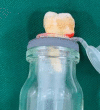Apical Debris Extrusion with Conventional Rotary and Reciprocating Instruments
- PMID: 36704322
- PMCID: PMC9723214
- DOI: 10.22037/iej.v15i1.23823
Apical Debris Extrusion with Conventional Rotary and Reciprocating Instruments
Abstract
Introduction: The aim of the present study was to compare the amount of apical debris extrusion after preparation using hand files, reciprocating files, and full rotary nickel-titanium systems.
Methods and materials: One hundred extracted human mandibular molars with two separated canals in mesial root were divided into five groups and prepared using reciprocating systems (Reciproc file and Safesider endodontic reamers file), full rotary systems (Mtwo and Neoniti A1 files) and hand instrumentation systems. Endodontic access was prepared and a #15 K-file was passed beyond the apex of the mesiobuccal canal by 1 mm to ensure the canal patency. All mesiobuccal canals were prepared 1 mm shorter than the anatomic apex. In each case, extruded debris was collected in an Eppendorf tube and weighed after desiccation. The mean weight of extruded material was calculated in each group. The analysis was carried out using the Kruskal-Wallis test followed by two tailed and Mann-Whitney U test at a significance level of 0.05. The Bonferroni correction was also applied to correct multiple comparisons.
Results: There was a statistically significant difference between the reciprocal and other techniques in debris extrusion (P<0.05). The order of groups ranked in terms of debris extrusion from the lowest to highest was as follows: 1) Hand instrumentation group (with crown down technique), 2) Mtwo group, 3) Neoniti A1 group, 4) Safesider endodontic reamer group, and 5) Reciproc group.
Conclusion: Based on this in vitro study, all systems have some apical debris extrusion; however, using the hand instrumentation system resulted in extrusion of significantly less debris compared to the Reciproc group. It seems that hand and rotary instrumentation systems are better than reciprocating instrumentation systems in terms of the amount of debris extrusion.
Keywords: Endodontics; Root Canal Preparation; Rotary Instrumentation.
Conflict of interest statement
‘None declared’.
Figures
Similar articles
-
Effects of Different Glide Path Files on Apical Debris Extrusion in Curved Root Canals.J Endod. 2018 Jul;44(7):1191-1194. doi: 10.1016/j.joen.2018.04.012. Epub 2018 Jun 5. J Endod. 2018. PMID: 29884338
-
Apical extrusion of debris using reciprocating files and rotary instrumentation systems.Niger J Clin Pract. 2016 Jan-Feb;19(1):71-5. doi: 10.4103/1119-3077.173715. Niger J Clin Pract. 2016. PMID: 26755222
-
Apical extrusion of debris and irrigants using hand and three rotary instrumentation systems − An in vitro study.Contemp Clin Dent. 2010 Oct;1(4):234-6. doi: 10.4103/0976-237X.76390. Contemp Clin Dent. 2010. PMID: 22114427 Free PMC article.
-
Effect of mode of rotation on apical extrusion of debris with four different single-file endodontic instrumentation systems: Systematic review and meta-analysis.Aust Endod J. 2022 Apr;48(1):202-218. doi: 10.1111/aej.12612. Epub 2022 Mar 7. Aust Endod J. 2022. PMID: 35255170
-
Effectiveness, efficiency, and apical extrusion of 2 rotaries and 2 reciprocating systems in removing filling material during endodontic retreatment. A systematic review.J Clin Exp Dent. 2023 Mar 1;15(3):e250-e263. doi: 10.4317/jced.59953. eCollection 2023 Mar. J Clin Exp Dent. 2023. PMID: 37008238 Free PMC article. Review.
Cited by
-
Impact of root canal shaping using TruNatomy on postoperative pain and operative torque generation: a randomized clinical trial.BMC Oral Health. 2025 Jul 19;25(1):1222. doi: 10.1186/s12903-025-06418-z. BMC Oral Health. 2025. PMID: 40684114 Free PMC article. Clinical Trial.
-
Endodontic management of a tooth with apical overfilling and perforating external root resorption: A case report.Clin Case Rep. 2020 Oct 15;8(12):3278-3283. doi: 10.1002/ccr3.3406. eCollection 2020 Dec. Clin Case Rep. 2020. PMID: 33363918 Free PMC article.
-
Apical debris extrusion with Denco Gold and Blue rotary files: An in vitro study.Dent Res J (Isfahan). 2025 May 22;22:22. doi: 10.4103/drj.drj_526_24. eCollection 2025. Dent Res J (Isfahan). 2025. PMID: 40502447 Free PMC article.
-
The Effect of Reciprocating and Rotary Systems on Postoperative Endodontic Pain: A Systematic Review and Meta-analysis.Iran Endod J. 2020 Fall;15(4):198-210. doi: 10.22037/iej.v15i4.23778. Iran Endod J. 2020. PMID: 36704110 Free PMC article. Review.
-
Effect of Reciprocating and Rotary Systems on Postoperative Pain: A Systematic Review and Meta-Analysis.Iran Endod J. 2021;16(1):1-16. doi: 10.22037/iej.v16i1.27944. Iran Endod J. 2021. PMID: 36704409 Free PMC article. Review.
References
-
- Martin H, Cunningham WT. The effect of endosonic and hand manipulation on the amount of root canal material extruded. Oral Surg Oral Med Oral Pathol. 1982;53(6):611–3. - PubMed
-
- Siqueira Jr J. Microbial causes of endodontic flare‐ups. Int Endod J. 2003;36(7):453–63. - PubMed
-
- Seltzer S, Naidorf IJ. Flare-ups in endodontics: I Etiological factors. J Endod. 1985;11(11):472–8. - PubMed
-
- Bürklein S, Benten S, Schäfer E. Quantitative evaluation of apically extruded debris with different single‐file systems: R eciproc, F 360 and O ne S hape versus M two. Int Endod J. 2014;47(5):405–9. - PubMed
LinkOut - more resources
Full Text Sources
Miscellaneous

